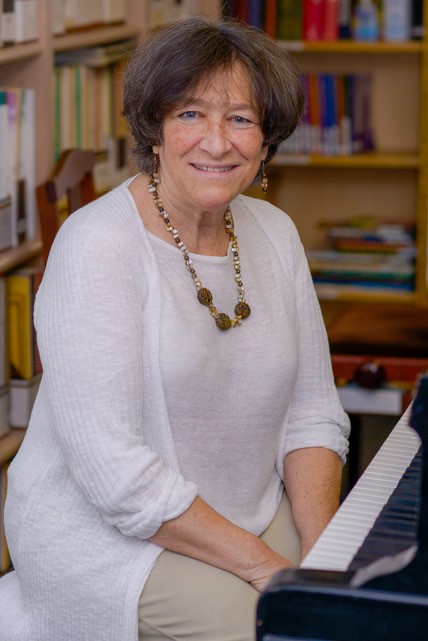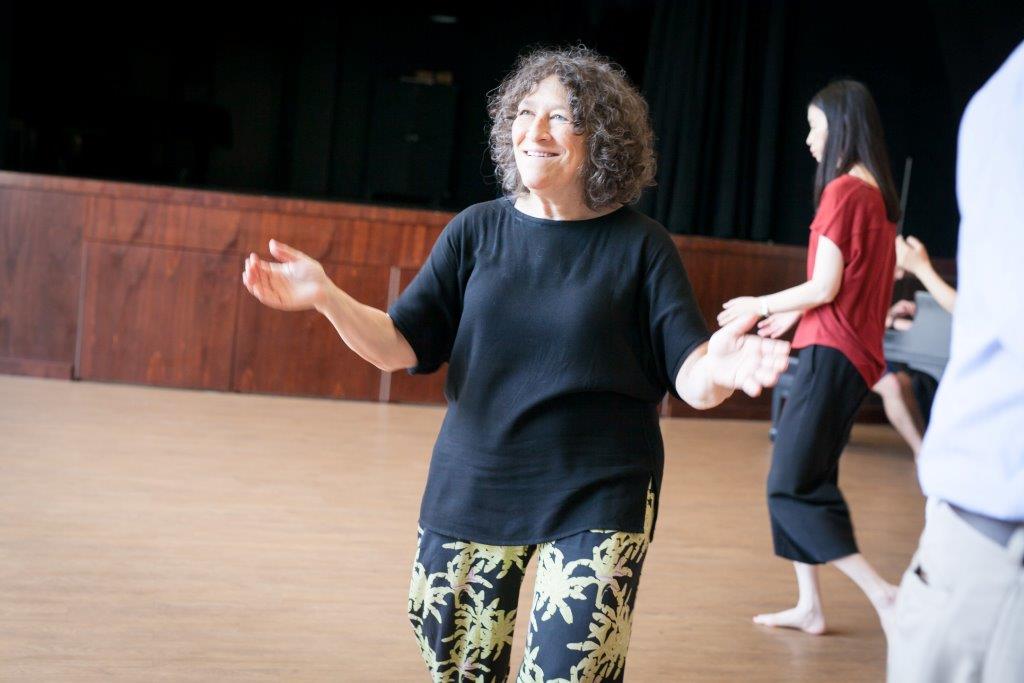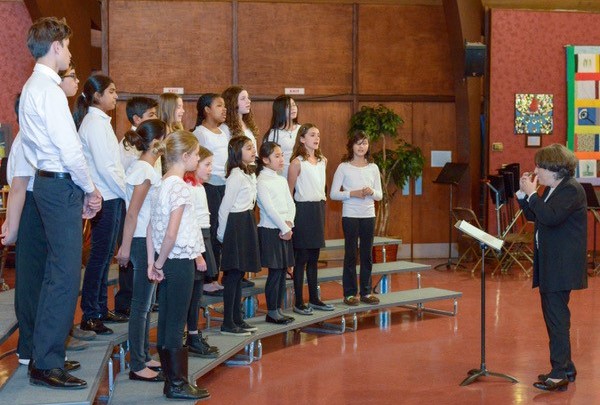Ruth Alperson: Dean Emerita

Ruth Alperson has played nearly every conceivable role at Hoff-Barthelson Music School.
Ruth has been part of the Hoff-Barthelson community as a student, alumna, teacher, parent (her son Jeremy studied trumpet with Joe Albright), Dean, and now Dean Emerita for nearly six decades. Six decades – almost the entire history of the school. During this time, her passion for music and her dedication to sharing that passion with others never wavered. She has nurtured several generations of child and adult music learners and has trained a legion of educators who have themselves further spread the joy of music.
Ruth’s relationship with the school began when she was just two years old. At that time, her family lived in Hartsdale and her mother was looking to resume a long-dormant interest in piano. Ruth’s mother’s childhood piano teacher recommended Joyce Barthelson as a good nearby instructor. As her mother studied with Joyce, Ruth would sit under the piano (for endless hours), absorbing the music and later demanding that her mother teach her the pieces she herself was learning, Rachmaninoff G Minor Prelude and a Bach Suite in Eb Major, for example. Tiny Ruth learned the first pages of many masterpieces at home from her mother and, by osmosis, from Joyce Barthelson.
When Ruth was nine years old, she began taking her own lessons, with then brand new piano instructor Mary Helton. The lessons were conducted at Virginia Hoff’s home. Mary, who would eventually become the School’s Director, gave Ruth’s piano education structure, teaching her how to read music and how music theory related to what she had been initially playing by rote. Ruth studied with Mary for nearly 10 years, in preparation for college auditions.
Ruth was accepted early decision to the Conservatory at Oberlin College, applying there because of their progressive views on the admission of women and people of color, in addition to their excellent music program. She studied piano with Emil Denaneberg who later became president of Oberlin College. After two years at the Conservatory, Ruth realized that, while music remained her calling, a career as a performer was not where her interests were. She transferred to the Oberlin School of Liberal Arts, becoming a music major there. She took a brief detour to study harpsichord, as well as the music and liberal arts curriculum of the college. Her life’s trajectory changed in her last semester of college, when she enrolled in a class called Eurhythmics, mostly because it fit into an opening she had in her schedule.
Her Eurhythmics instructor was Inda Howland, an intimidating but engaging figure who showed Ruth the intersection between movement and music. Ruth was moving back to the New York area and wanted to continue exploring this idea. Howland recommended that Ruth look into the Dalcroze School of Music, under the direction of Dr. Hilda Schuster, which offered a full curriculum of Dalcroze studies Eurythmics classes. Ruth studied there for a year, after which she moved to Cambridge, Massachusetts, and continued to study Eurythmics there with renowned teacher Lisa Parker. She then went back to the Dalcroze School in New York for a year. (Annie Lennox is an alumna of this school; her group, “The Eurhythmics,” takes its name from the method.)

Eurhythmics (“good rhythm,” Gr.) is an approach, developed by the Swiss composer, music educator, and author, Émile Jaques-Dalcroze (1865-1950). Dalcroze was inspired by progressive educators and psychologists of his time who encouraged learning from the world around us, through our senses, through experience, exploration, and discovery. Likewise, Dalcroze believed that listening, allied with movement, offered unique ways to use the body as a learning medium, in teaching music and music concepts to the whole person. The general idea was that learning began with activity: singing, moving, improvising. Afterwards, the experiences were analyzed; the practice promoted the idea of experience first, theory later. Dalcroze applied his ideas with conservatory students in his harmony classes, with great success. La rythmique Dalcroze was soon applied by his students and colleagues in music classes for children of all ages. The ear and body were trained and developed first, through action: singing, clapping, using small percussion instruments, and improvising. This dynamic, hands-on approach was embraced by educators, who observed its educational benefits for children of all ages.
Circumstances brought Ruth to London, England, where a new Eurhythmics teacher training course was being established by a prominent European British instructor, Elizabeth Vanderspar. Several of the members of that class became noted Dalcroze Eurhythmics instructors around the globe, as well as Ruth’s lifelong friends and colleagues. Ruth sat for and passed the examination for the Licentiate in Dalcroze Studies; she was evaluated by M. Dominique Porte, the head of L’Institut Jaques-Dalcroze, the premier Eurhythmics school in the world and the certifying institution for the Dalcroze Diploma, which, under a special set of requirements, confers on the holder the right to certify Dalcroze teachers. M. Porte invited her to study at the Institute. At the time, Ruth’s marriage was amicably ending and she and Jeremy moved to Geneva, Switzerland, where Ruth earned the Diplôme Supérieur.
A classmate at the Institute, Louise Mathieu, was teaching in a Eurhythmics program at l’Université Laval in Quebec City and he invited now fully-credentialed Ruth to become an instructor in her program. She taught there for two years. Following this, she moved back to New York to be near family. Mary Helton immediately brought Ruth back into the Hoff-Barthelson fold, offering her a part-time teaching position to educate HB students in piano and Eurhythmics. Ruth’s employment at the school began in 1978.

During her early time teaching at Hoff-Barthelson, Ruth also served as an adjunct professor at New York University in the Department of Music Education, as well as variously teaching at the Manhattan School of Music, the Lucy Moses School Kaufman Music Center, the Diller Quaile School of Music, and at the Rockefeller University children’s school, the last of which was the inspiration for Hoff-Barthelson’s longtime preschool program, providing an introduction to music for many of Westchester’s youngest citizens.
Three years before Mary Helton retired, Ruth became the school’s first Dean, a position she held for 21 years. As Dean, Ruth interfaced with families, worked on curriculum design for younger musicians, did administrative work, continued serving on the Financial Aid Committee, and taught Eurhythmics and choir to young people and Eurhythmics training to adults.
Additionally, Ruth was instrumental in establishing a Dalcroze teacher training program, with the permission of L’Institut Jaques-Dalcroze in Geneva. Graduates of the program, which Ruth ran for twenty years, include Hoff-Barthelson’s own Kathy Jones and Laura Barnet, who became certified Dalcroze teachers through the program, as well as countless others.
Ruth is especially proud of Hoff-Barthelson’s commitment to making music education available for children and adults in need of financial assistance. Since the School’s founding, Hoff-Barthelson’s financial aid program has maintained tremendous support from the community. Through Hoff-Barthelson’s outreach programs in surrounding areas, the School extends opportunities for music learning and music making to our neighbors in Westchester.
As a student, teacher, and then Dean, Ruth has loved being a part of the Hoff-Barthelson community. As Dean, she particularly cherished her interactions with a devoted, hard-working, and talented staff.

As a music pedagogue who has worked in a wide range of educational settings, Ruth wishes to recognize her gifted colleagues on the Hoff-Barthelson faculty, many of whom have taught at the School for years or even decades. Ruth has deeply enjoyed working with and learning from these educators, among whom are many gifted performers, all with a passion for music and a love for teaching. Their humanity, intelligence, humor, and dedication to their work, have nurtured Ruth’s growth as a teacher and person, and made it a pleasure for her to work at Hoff-Barthelson.
For all of these reasons and more, the Board is thrilled to announce the establishment of the Ruth Alperson Fund for Excellence in Music Education, which will honor and maintain Ruth’s legacy by sustaining the excellence of the School’s educational programs and supporting the work of its outstanding faculty.
Music changes lives for the better – and there is no bigger testament to that than the life and career of Ruth Alperson. It has been Hoff-Barthelson’s great good fortune to have had Ruth’s talent; her dedication to nurturing the musical abilities, and the humanity, of children and adults; her warmth and compassion for individuals and the community as a whole; and her wholehearted love of the gift of music for so very many years.


 Developing potential, enriching lives and creating community since 1944
Developing potential, enriching lives and creating community since 1944 








